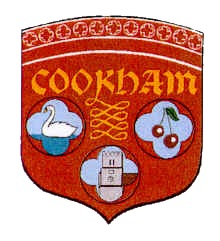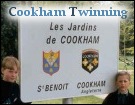 Cookham
is a largish village situated in Berkshire,
England, of around
Cookham
is a largish village situated in Berkshire,
England, of around A Little Cookham History
The Cookham Emblem
 Cookham
is a largish village situated in Berkshire,
England, of around
Cookham
is a largish village situated in Berkshire,
England, of around
Cookham's history goes back to the Ancient Britains, then through Romans, Vikings, Anglo Saxons and Domesday. It is actually made up of three villages, Cookham Village, Cookham Rise and Cookham Dean. Until Victorian times Cookham Dean was considered a rough area to live and generally unsafe. This has changed drastically in the last fifty years, as it is now very much a desirable and expensive area in which to live. Cookham Village is a true picture post card area, with many houses going back to the 16th and 17th centuries. Up to the 20th century it was very much a working village. It is now full of French clothes shops and restaurants, but still an attractive place to visit. Cookham Rise is in the middle and has shops that actually sell food and provisions and also a train station on the Marlow to Maidenhead line. There are one or two direct trains to London, Paddington on a daily basis, but normally one needs to change at Maidenhead.
The Cookham Emblem only came into being in 1994 when Cookham was to be twinned with St Benoit in France. The Twinning Committee had spent some time finding out if Cookham had ever had a crest and were unable to discover one, so in association with the Parish Council they asked Charles Wilson, a designer living at Westwood Green, to design a suitable crest for them. The emblem appears on the Cookham road signs, which were unveiled at the Twinning Ceremony, which took place on 3rd. September 1994. Sadly Charles Wilson died before he was able to see his design actually on the signs for all to see. It can also be seen in St Benoit by ‘Les Jardins de Cookham’, a beautiful garden, which was a present from the people of St Benoit to the people of Cookham.
 The emblem represents
Cookham and has a swan, a cherry and a church on it. Along the top of the emblem, the
ironwork on Cookham Bridge is depicted. The bridge was renovated in 1999 as it
had been discovered that the iron work was crumbling. The bridge is Grade
II listed and so the repair had to be checked by English Heritage. Although the
colour of the renovated bridge was criticised, it was in fact the original
colour when it was first constructed. It has now faded and is acceptable to
everyone again.
The emblem represents
Cookham and has a swan, a cherry and a church on it. Along the top of the emblem, the
ironwork on Cookham Bridge is depicted. The bridge was renovated in 1999 as it
had been discovered that the iron work was crumbling. The bridge is Grade
II listed and so the repair had to be checked by English Heritage. Although the
colour of the renovated bridge was criticised, it was in fact the original
colour when it was first constructed. It has now faded and is acceptable to
everyone again.
The swan represents the Thames running through the village, which is very much part of Cookham. Kenneth Graham was said to have dreamt that Ratty and Mole sat on the banks of the Thames in Cookham and had their picnics. Swan Upping, the marking of the mute swans takes place the third week in July each year by the
Vintners' Company, The Dyers' Company and The Monarch's Swan Marker. It starts from Sunbury Lock on the Monday and comes to Cookham on the afternoon of the Tuesday. Since medieval times the crown has claimed ownership of all mute swans, although this is now more of a tradition. The swan markers reach Abingdon by the Friday. Originally the marking was completed in a day. On the first Saturday of September the Cookham Regatta takes place. This was revived in the late 1980s after it had lapsed for many years.The Church represents Holy Trinity. Holy Trinity has been on the site for over a millennium, although there have been many changes and additions in that time. During the latter part of the 20th century the tower was repaired. In the early part it had been covered with ivy which had started to destroy the stonework. The original vicarage is now used as the Parish Centre which is available for rent for activities. A new vicarage was built in the 1980s.
The cherries represent the Kaffirs or cherry pickers, who used to work in the many cherry orchards in Cookham Dean. The cherry orchards have sadly dwindled away over the years, so the cherry pickers are no more, but the name Kaffirs lives on in a group of individuals living in Cookham whose aim is to support local charities and are famed for the Kaffirs Pig Roast which is held once a year at the Jolly Farmer pub in Cookham Dean during the month of July.
|